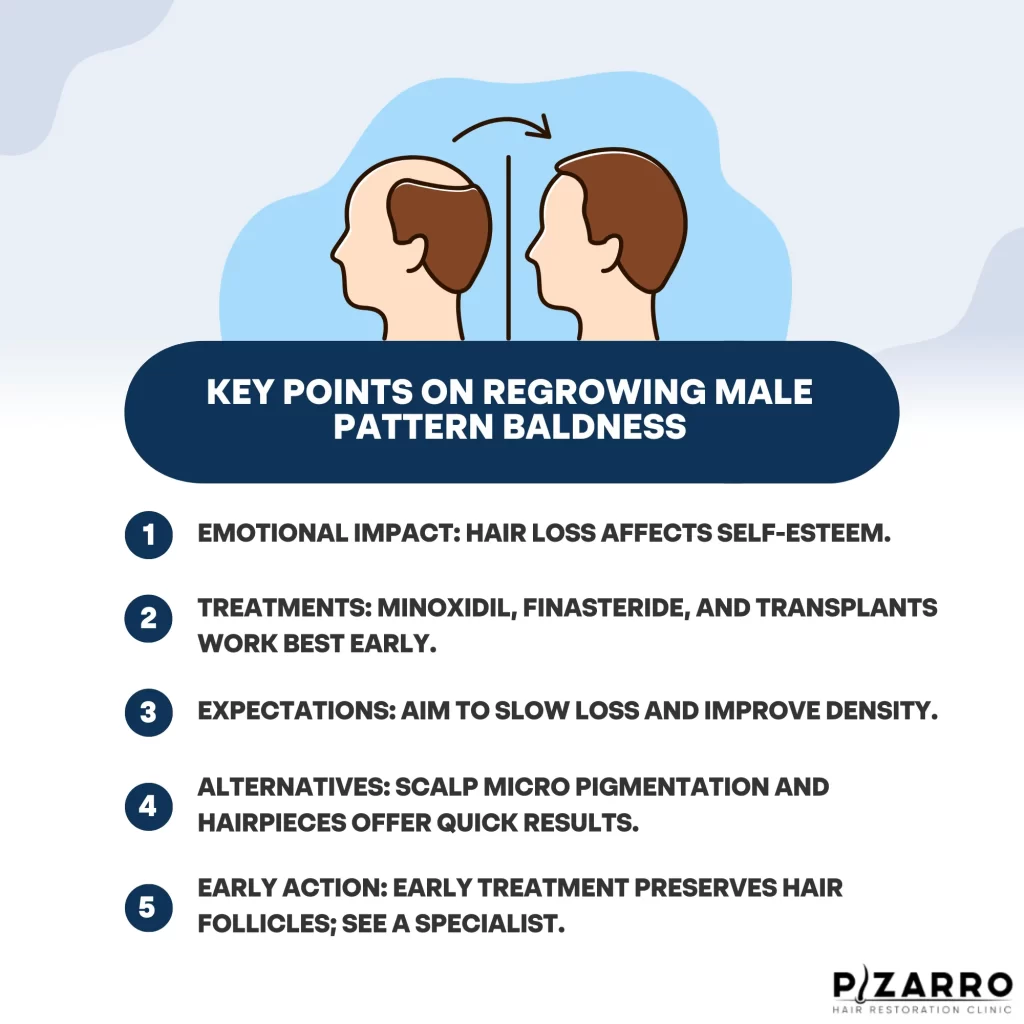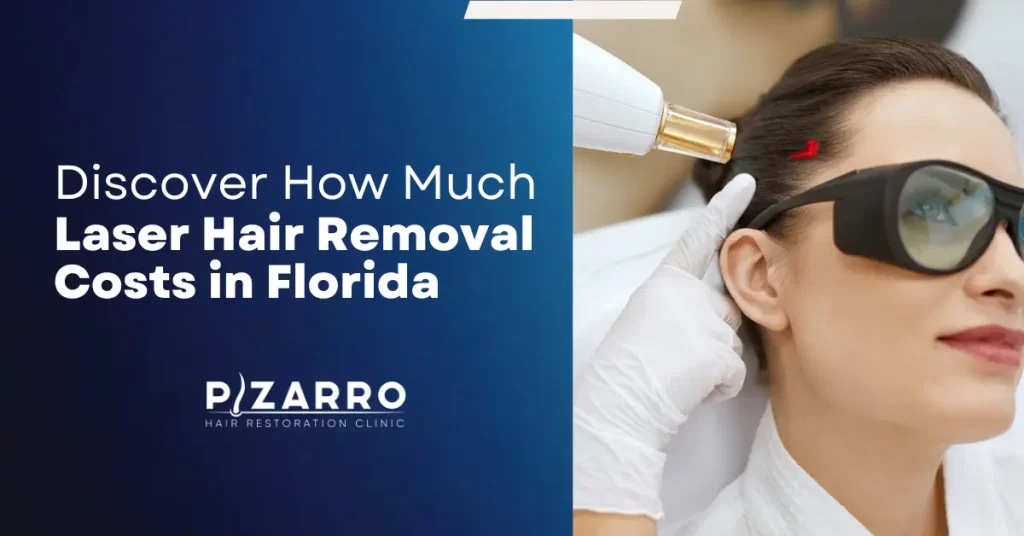Men worldwide are commonly affected by balding, which is a significant concern for many. The receding hairline, a hallmark of male pattern baldness (MPB), can be a source of anxiety and a blow to self-confidence. But amidst the worry and misinformation, a crucial question arises: can you actually regrow lost hair?
This article separates fact from fiction, exploring the realities of MPB treatment and empowering men to navigate their hair loss journey.
Facing Hair Loss
Hair loss isn’t merely cosmetic. It has more profound effects. When a man’s hair is falling out, it can significantly affect how he feels about himself and how comfortable he is in social situations. The fear of appearing older or less attractive can be a real emotional burden. However, it’s important to remember that hair loss is a shared experience, and there are solutions available.
Can You Regrow Lost Hair?
The good news is that complete hair regrowth is still a possibility, especially with early intervention. However, complete restoration is only sometimes achievable, and unrealistic expectations can lead to disappointment. The key lies in understanding the underlying cause of hair loss and exploring effective treatment options.

The Male Pattern Baldness (MPB)
MPB, the most common form of hair loss in men, is a genetic predisposition. It is also referred to as androgenetic alopecia. It’s characterized by a gradual thinning of hair, typically beginning at the temples or crown of the scalp. The culprit behind this process? A hormone called dihydrotestosterone (DHT). DHT shrinks hair follicles, shortening their growth phase and eventually leading to miniaturization – the transformation of healthy follicles into vellus hairs (fine, barely visible hairs).
The Stages of MPB
MPB progresses through predictable stages, often categorized by the Norwood-Hamilton classification system. Early signs might be a slightly receding hairline or a widening widow’s peak. As MPB progresses, the hair loss becomes more noticeable, with a horseshoe-shaped pattern of baldness forming on the scalp.
Identifying the Signs
Early detection is crucial for successful treatment. Be on the lookout for:
- A receding hairline, particularly at the temples.
- Increased hair shedding is especially noticeable in the shower drain or on your comb.
- A general thinning of hair density makes the scalp more visible.
- A maturing hairline, where the frontal hairline takes on a higher, M-shaped appearance.
These signs often present gradually, so vigilance is vital.
Exploring Treatment Options for MPB
While there’s no single cure-all for MPB, a multifaceted approach combining various strategies can be highly effective. Here’s a breakdown of some popular options:
Embracing a Healthy Lifestyle:
- Diet: Eating foods with critical nutrients helps keep your scalp healthy and supports hair growth.
- Exercise: Exercising regularly can help improve blood flow, which can, in turn, help with hair growth.
- Stress Management: Chronic stress can exacerbate hair loss. Techniques like meditation, yoga, or deep breathing can help manage stress levels.
The Power of Over-the-Counter Solutions:
- Minoxidil: This topical medication is clinically proven to stimulate hair growth in some cases. It helps hair grow by extending the anagen (growth) phase of the hair follicle cycle.
Finasteride: A Prescription Medication to Combat DHT:
- Finasteride, a prescription medication, slows hair loss by blocking the conversion of testosterone to DHT.
Low-Level Laser Therapy (LLLT): Exploring Emerging Technologies:
- Low-level laser therapy (LLLT) involves exposing the scalp to low-level laser light. While research is ongoing, it shows promise in promoting hair growth by stimulating cellular activity in the scalp.
Hair Transplant Surgery: A Permanent Solution for Advanced Hair Loss:
- Hair transplant surgery moves healthy hair follicles from the back of the scalp to areas with hair loss or thinning. This procedure requires careful consultation with a qualified hair transplant surgeon.
Understanding the Effectiveness of Treatments
It’s crucial to set realistic expectations when considering treatment options. Most treatments take time to show results, often several months. Additionally, complete hair regrowth might only sometimes be achievable. The primary goals are usually to slow down hair loss, improve hair density, and promote overall hair health. Consistency is vital – sticking with your chosen treatment regimen for the long term is essential for optimal results.
Hair Loss Concealment Techniques
While treatment options can be a great starting point, there are also solutions for those seeking immediate visual improvement:
- Scalp Micropigmentation: This non-surgical technique involves creating tiny pigmented dots on the scalp, mimicking the appearance of a shaved head or a buzz cut.
- Hairpieces and Toupees: Hairpieces offer a way to add volume and coverage to thinning areas. They come in various styles and require proper maintenance for a natural look.
- Embracing a New Look: Exploring shorter hairstyles that complement your hair loss pattern can be a great way to maintain a confident appearance.
Addressing Hair Loss at the First Signs
Early intervention is paramount when dealing with MPB. Here’s why:
- Benefits of Early Diagnosis: Early diagnosis allows for treatment to begin before hair follicles become miniaturized, potentially leading to better results.
- Preserving Hair Follicles: Once hair follicles are entirely miniaturized, they become non-functional and unable to produce new hair growth. Early intervention can help preserve these follicles for potential regrowth.
Finding a Qualified Hair Loss Specialist
Consulting a board-certified dermatologist or a reputable hair restoration clinic is crucial for proper diagnosis and treatment plan development. They can evaluate your situation, suggest suitable options including a viable plan for hair regrowth for men and track your progress.
The Emotional Journey of Hair Loss
Hair loss can trigger feelings of insecurity and negatively impact self-esteem. Here are some strategies to navigate these emotions:
- Coping with Hair Loss: Focus on self-care practices that promote a positive self-image. Try hairstyles that fit your face shape and boost your confidence.
- Seeking Support: Therapy can help you manage stress and develop healthy ways to cope with hair loss. Consider joining a hair loss support group to connect with others facing similar experiences.
- Focusing on Overall Well-Being: Prioritize your mental and physical health. Exercising, eating well, and sleeping enough can improve how you feel about yourself and help keep your hair healthy.
Combining Treatments and Embracing Self-Acceptance
The most successful approach to MPB often involves a combination of strategies. This might include using medications like minoxidil or finasteride alongside stress management techniques and a healthy lifestyle. Additionally, exploring hair loss concealment options like scalp micropigmentation or finding a complementary hairstyle can boost immediate confidence.
Remember, complete hair restoration might only sometimes be achievable. Embracing self-acceptance and focusing on your overall well-being are crucial aspects of navigating hair loss.
Living a Full Life Despite Hair Loss
Hair loss doesn’t define you. Countless successful, confident men manage MPB. Here are some inspiring examples:
- Dwayne “The Rock” Johnson: This action hero embraces his shaved head, showcasing strength and confidence that transcends a full head of hair.
- Vin Diesel: This Hollywood A-lister rocks a receding hairline with charisma, proving that a full head of hair isn’t necessary for success.
- Jason Statham: This action star’s shaved head complements his tough-guy persona, demonstrating that hair loss can be a powerful style choice.
These men, and many others, inspire us to embrace ourselves, hair loss and all.
Final Thoughts
Hair loss is a shared experience, and you are not alone. Understanding the causes, exploring treatment options, and prioritizing your well-being can help you take control of your hair loss journey. Remember, confidence comes from within, and a full head of hair isn’t a prerequisite for a fulfilling life. Embrace your unique style, prioritize your well-being, and live life to the fullest, with or without a full head of hair.
Reclaim Your Confidence: Schedule a Free Consultation at Pizzaro Hair Restoration Clinic Today!
Looking for an experienced team that offers personalized male pattern baldness treatment in Orlando? Face the problem with Pizzaro Hair Restoration Clinic. You would not need to worry about medication, hair transplantation, and advanced therapies. We are committed to helping men in Orlando regain their confidence by understanding the emotional impact of hair loss. Schedule a consultation with Pizzaro Hair Restoration Clinic today and explore the possibilities for restoring your hair and your confidence.






